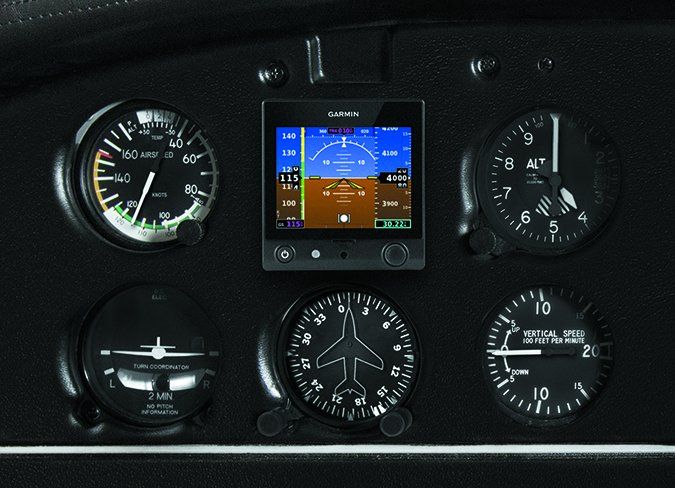The FAA turned a regulatory corner last year when it gave the green light to replace spinning attitude gyros (and vacuum systems) with TSO’d standalone solid-state electronic attitude instruments. It wasn’t long before Dynon—partnering with the Experimental Aircraft Association (EAA)—announced an AML-STC to retrofit its experimental D10A EFIS into lower-end Part 23 aircraft. As expected, Garmin competitively and swiftly earned a more extensive AML-STC for its experimental G5 EFIS just a few months later.
The D10A and G5 have similar form, function and pricing, which confuses the buying decision. They both sport decent color displays that mimic primary flight displays (PFDs) and they’re designed for an easy retrofit. Plus, they are both priced under $3000. In this article, we put the two instruments side-by-side for a look at their differences and limitations.
Instrument Retrofits: Then and Now
The instrument retrofit market has changed considerably in the last year (we covered digital attitude indicators in the December 2015 issue of Aviation Consumer). At the time, Sandia Aerospace finally emerged from the trenches of TSO certification with its SAI-340 Quattro backup attitude indicator. This was perfectly timed around the FAA’s policy statement allowing for electronic attitude instruments for installation as primary systems.
At $3600 (not counting install), we thought Sandia ruled the roost because it was priced considerably less than L-3’s $6000 ESI-500 Genesis, which was really a mini-EFIS intended as a backup for larger primary glass PFDs.
BendixKing also announced the KI300, an electronic replacement for its aging and maintenance-intensive analog KI-256 flight director gyro. It was supposed to have a $5000 starting price, but BendixKing still hasn’t brought it to market and has remained mostly silent on the product’s progress.
But Garmin and Dynon didn’t have to start from scratch. Each company already had low-cost EFIS displays aimed exclusively for the experimental aircraft market. Rather than dealing with the lengthy process and high cost of earning TSO certification, Dynon (partnering with EAA, the D10A’s STC holder) and Garmin lobbied installation approval through an STC. The STC governs how the instruments are installed, which means any deviation to the approved AML-STC installation manuals will require additional certification via FAA field approval.
Garmin says the electronics in the G5 meet the DO-334 performance requirements needed for TSO on its certified AHRS systems, although the instrument doesn’t have a TSO.
Supporting Backup Instruments Stay
While the D10A and G5 are essentially mini-EFIS systems—plenty capable to serve as primary one-and-only flight displays just as they are in experimental aircraft—the STC for each requires the use of supporting backup instruments.
The FAA issued each STC for the sole purpose of replacing the attitude gyro even though both instruments bring far more functionality to the table. These other functions—including airspeed, altimetry and track data, to name a few—are secondary and supplemental only. Moreover, there is no autopilot interface or nav/GPS course guidance displayed.
But what if you wanted to buy a pair of G5s or D10As and place them side-by-side in the panel and ditch the airspeed and altimeter instruments? You know, build your own low-cost glass panel. You can’t do it because the AML-STC doesn’t allow it—the instruments aren’t TSO’d. Dynon’s STC requires a panel placard reminding you that non-attitude indications are not for reference in flight. Silly, but those are the rules. Garmin told us the G5 can’t even be used to legally back up its certified G500/600 primary flight display or a G1000.
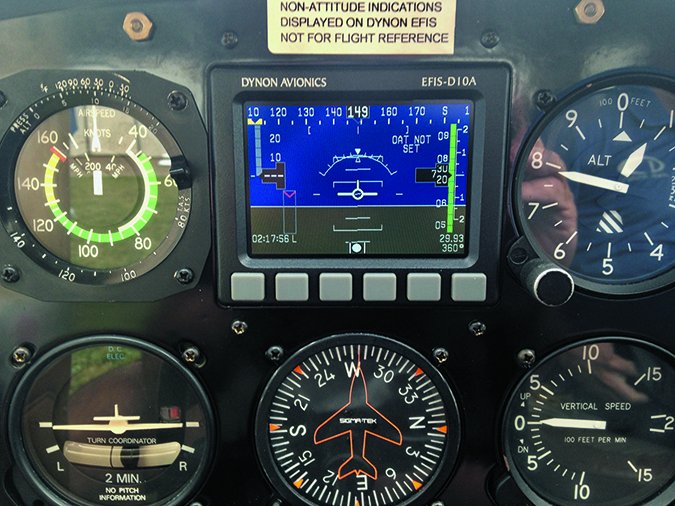
Each STC specifically prescribes where the instrument is located on the panel. When installing the D10A, Dynon’s instructions say you must maintain the six-pack orientation of the existing primary flight instruments. In other words, you can’t rearrange them, plus the D10A must be placed where the previous round-gauge attitude gyro was installed.
Garmin’s G5, on the other hand, is approved as a replacement for either the attitude indicator or the turn coordinator (not both), so it can be placed in either position.
As for the AML (approved model list), Dynon came out of the gate with limited applications in the first revision of the STC. Remember, EAA’s intent in securing the STC was to make the instrument accessible to buyers with lower-end aircraft. This includes Cessna 150/152/172/175/177/182 and Piper PA24/28/32/38 models.
According to the STC, the aircraft must, per the original type certificate, have been equipped with a pneumatically driven attitude indicator at time of manufacture to be eligible. As with any STC, the installation has to be signed off by an A&P with Inspection Authorization (or an FAA repair station) and requires the filing of a Form 337.
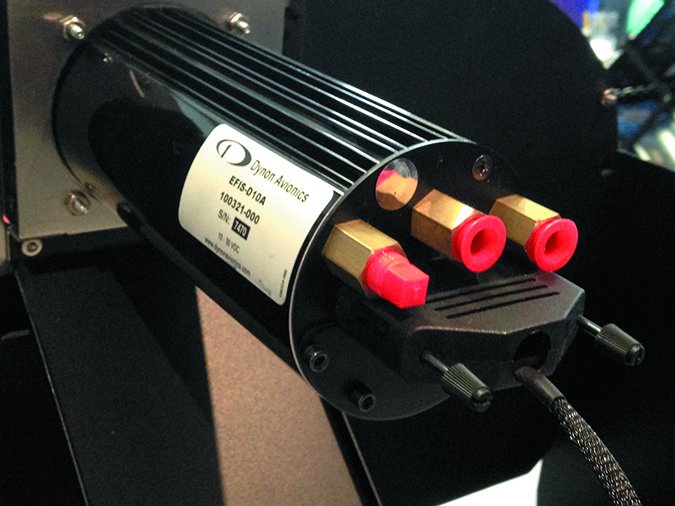
Garmin’s G5 AML is far more comprehensive, encompassing 562 aircraft models, which Garmin says it plans to expand.
Display, Form Factors of the EFIS
The STC’d version of Dynon’s EFIS-D10A trickles down from the D10A it has been selling for nearly 10 years, while Garmin’s G5 was released just last year. Put the two side-by-side and the advancements in display technology are evident.
We wouldn’t exactly label the D10A’s 3.8-inch diagonal color LCD display as being outdated, but it doesn’t have the vibrancy of Garmin’s newer G5, in our opinion.
At 3.5 diagonal inches, the G5’s QVGA color LCD display is slightly smaller. It has a display resolution of 320 by 240 pixels. Check that against the D10A’s 320 by 240 pixel, 450-nit LCD display. Same pixel count—but we give the G5’s QVGA the edge in viewing quality.
Both the D10A and G5 require a pitot and static source inputted directly to fittings on the rear of the instrument’s chassis. We give Garmin’s G5 a slight installation advantage because of its shallow footprint—measuring only 2.6 inches deep. The D10A’s chassis is every bit of 7 inches deep, plus the harness (fabricated by Dynon) extends an additional few inches. Panel depth isn’t the only consideration. Since the D10A is 4.09 inches wide, some Cessna 172 retrofits require the installation of a new subpanel to support a slightly wider spacing between the airspeed and altimeter instruments.

The D10A can be mounted in a standard configuration (with an external bezel) or flush mounted, using an optional flush-mount bracket.
The Garmin G5’s bezel is 3.4 inches wide and 3.6 inches high—allowing for plenty of space between the other instruments. We like that the G5 can be removed and reinstalled from the front of the instrument panel—no need to access the back of it.
The D10A and G5 share a straightforward electrical installation and both require GPS position for backing up the attitude solution. We think Garmin has the advantage here because the D5 accepts input from the GNS430W/530W (legacy non-WAAS navigators won’t work) and the current GTN750/650 navigators via serial bus. The other option is using the GPS engine that’s built into the unit, but that requires a dedicated antenna, increasing install effort and cost.
Dynon’s D10A connects with the external GPS251 GPS receiver/antenna, which is powered by the D10A with a supplied four-wire harness with a DB9 connector.
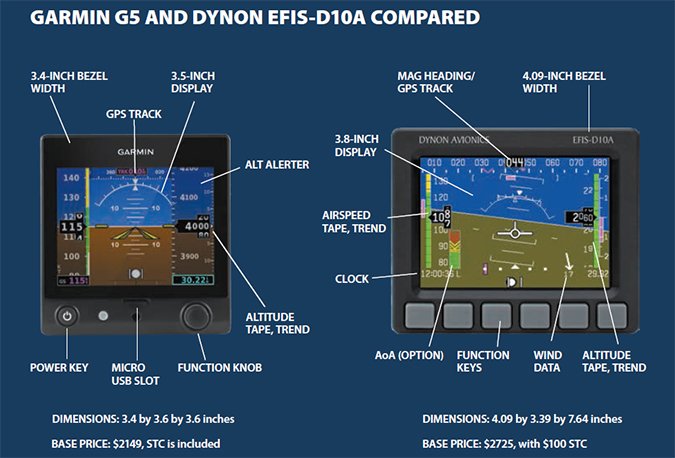
EFIS Standards and Options
In addition to displaying attitude, altitude, airspeed and turn rate/inclinometer, the D10A has a bus voltage display, G meter, timers and a clock. Also included is the internal backup battery, which has an endurance of two hours.
We think the optional EDC-D10A remote magnetometer is worth purchasing and gives the D10A an advantage over the Garmin. The EDC input replaces GPS ground track with a magnetic heading tape at the top of the display. But, expect a sizable installation effort to get this right. While the EDC can be installed pretty much anywhere in the aircraft, magnetometers don’t work we’ll when corrupted with electrical interference.
Garmin has a remote magnetometer interface with the G5 version for experimentals, but doesn’t offer it with the STC’d version. We heard rumors of a future EHSI interface, which we would embrace. The G5 doesn’t have an angle of attack function, either, but the D10A does.
When connected with the company’s AoA probe, the data logically displays next to the airspeed data. We found Dynon’s AoA to be a good performer with an easy calibration procedure. The probe has two static air pressure ports—one on the face, which is insensitive to the angle of attack—and another located on an angled surface of the probe, just under the pitot port. The software uses the difference between these two pressures to calculate the AoA. There is also an optional temperature probe, for OAT, density altitude and true airspeed display.
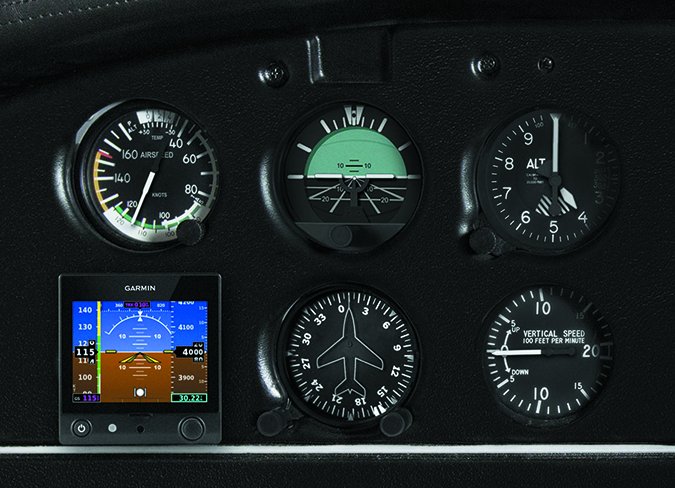
As for user feature set, Garmin keeps the menu structure shallow and only displays the G5 data in a single PFD format. A rotary knob is used to access the main menu and to set the baro and altitude alerter. The capacity status of the backup battery is shown in the upper left corner of the display. The ground track tape has a reference marker for minding a desired track, but remember, this isn’t magnetic heading.
Attitude information is displayed over a virtual blue sky and brown ground with a white horizon line, which is also part of the pitch scale. Pitch markings are spaced at 2.5-degree intervals and a yellow symbolic aircraft corresponds to the current pitch attitude. A slip/skid indicator is positioned at the bottom of the display, along with a magenta turn rate trend vector. Missing on the STC’d G5, but standard on the version for experimental aircraft, is a flight director command bar presentation because autopilot input is excluded from the STC.
The G5 has programmable V-speed references. When airspeed is present, the V-speeds are displayed at their respective locations to the right of the airspeed scale. The airspeed trend vector is displayed as a magenta line to the right of the tape. The end of the trend vector corresponds to the predicted airspeed in six seconds if the current rate of acceleration is maintained. If the trend vector crosses Vne, the text of the current airspeed readout changes to yellow.
The G5’s altitude alerting feature is logical. When passing within 1000 and again at 200 feet of a selected altitude, the set value flashes for five seconds. Bust the altitude by 200 feet and the selected altitude data box changes to yellow text against a black background. We think an audio output would make the interface better. Dynon’s D10A has an output for connecting to an audio system for altitude and AoA alerts.
The D10A’s bezel has six buttons for data entry and for accessing its menu system. The onscreen menu consists of two rows of grey text boxes denoting the currently displayed menu. There is also a lower row containing six more labels that denote the function of the button below it. We like that many of the primary onscreen elements shift up, so critical data isn’t obscured by the menu when it’s active.
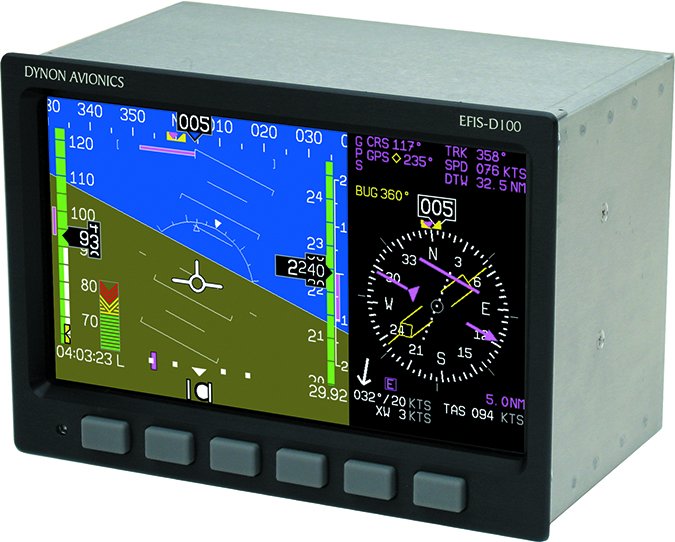
Each page has a dedicated menu, which may have options for hopping to another menu or adjusting parameters like the baro, setting the timer and adjusting the display backlighting.
The D10A’s horizon line, pitch and roll indicators are presented much like the G5’s. Bounded by blue at the top and brown at the bottom in traditional gyro-based artificial horizon fashion, the horizon line stays parallel to the earth’s horizon line regardless of the aircraft’s attitude. The parallel lines above and below the horizon line are the pitch indicator lines, with each line indicating 5 degrees of pitch. The end of each 10-degree pitch indicator line has a hooked barb that points toward the horizon line.
The roll scale has tic marks at 10, 20, 30, 45, 60 and 90 degrees of roll. The stationary roll indicator has an internal arrow that moves to stay perpendicular to the horizon, while a moving roll indicator rotates the scale about a stationary internal arrow, which points to the current roll angle on the scale. Again, this follows the display of most mechanical attitude instrument presentations.
The time clock (which can be set for local and Zulu time) is displayed in the lower left-hand corner of the screen, below the airspeed tape. When a count-down or count-up timer is enabled, it is displayed in place of the clock until the timer is stopped. With the optional OAT probe, a winds aloft arrow and wind speed is displayed on the lower corner of the display. In light winds, the arrow remains on the screen, but the speed value goes away.
The slip/skid ball works much like it does on a mechanical instrument. It is a visual representation of lateral acceleration. It’s simple: If the ball is within the two vertical lines, you are in coordinated flight.
Noticeably missing on both the D10A and G5 is synthetic vision. We think buyers will want it. Buyers may also want a built-in checklist feature and the D10A has it. You may define up to 25 checklists and each checklist/data panel can contain up to 14 lines of text and 40 characters per line. The checklists must be built and loaded through a serial port using Dynon’s Excel-based checklist creator programmer. The Garmin G5 doesn’t have a checklist function, but it does have a bezel-mounted micro USB port for loading software updates.
Both EFIS are Good Performers
We flew with both the G5 (an experimental version, which has the same internal sensors as the STC’d version), and the D10A. Both were solid performers. When the FAA issued the STC, this is rightfully what it cared about the most (and how the instruments interface with the pilot during a sensor failure).
We did light aerobatics with the D10A and it never flagged its data. The attitude presentation is generated from algorithms using multiple sensors and is not reliant on any single external system. A G meter shows the current, maximum and minimum acceleration.
Dynon says the instrument can provide an accurate attitude—even in the event of airspeed loss (due to icing or other blockage)—because of its redundant GPS assist function. In normal operation, the instrument uses airspeed to aid with attitude accuracy. If there’s trouble with the airspeed reference, the GPS groundspeed substitutes.
You’ll know when the airspeed input is lost because a magenta “GPS assist” message appears on the horizon display. A loss of GPS and airspeed data results in a “crosscheck attitude” message. That means using those backup flight instruments that the STC says need to stay in the panel. It’s still a lot of redundancy.
Consider Aspen’s Evolution PFD where an iced/blocked pitot tube will red-flag most of the displayed data.
The G5 calculates attitude using built-in inertial sensors. The instrument also uses GPS and airspeed data to tighten up the accuracy of the attitude information. The G5 should come up valid within one minute of initial power up. If the G5 senses that the attitude solution is valid, but not yet within the internal accuracy limits, an “aligning” message is displayed. The displayed attitude information is still accurate and usable while this indication is shown. The G5 can align itself while taxiing and during level flight. If the G5 inertial sensors fail, an “attitude fail” message is displayed, while the onscreen data is flagged with a red X.
We didn’t do them, but Garmin says the G5 is capable of handling extremely dynamic maneuvers, including aerobatics and air racing.
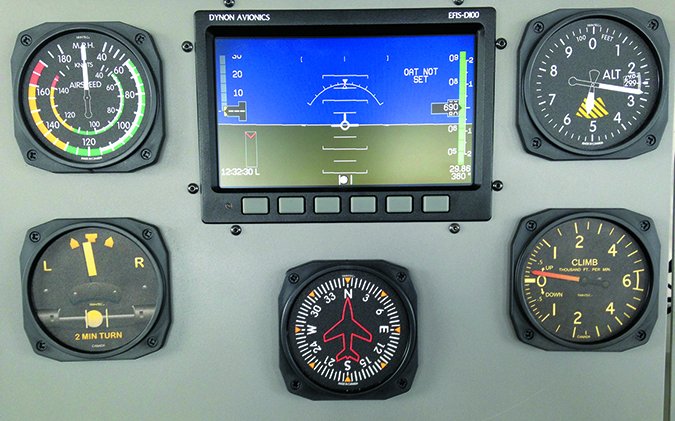
Dynon D100: Superbright Wide
The reality of using either the Dynon D10A or Garmin G5 in the real world is this: While the STC says the airspeed and altimeter tapes are intended for supplemental use (that’s why you gotta keep the backup instruments, right?) your eyeballs will be fixed to the screen for primary everything. As good as we think these displays are (with Garmin having the modern advantage), each instrument is jampacked with bits of data that can be a struggle for aging eyes. That’s where Dynon’s Superbright widescreen EFIS-D100 comes in.
With a 7-inch diagonal color LCD screen and a front bezel that measures 6.95 inches wide, the D100 easily dwarfs the D10A and Garmin G5. Moreover, the D100 is blanketed by EAA’s AML-STC, enabling it to be installed and used the same way as the smaller D10A. The same limitations apply—no autopilot or navigation interface is approved. The D100 has a G meter, timers, a voltmeter and accepts inputs from optional AoA and magnetic heading sensors. It also has a splitscreen.
Mounting the D100 requires cutting a 6.78 by 4.75 inch rectangular cutout on the surface of the panel, which will obviously displace the required backup instruments, so you’ll need to plan on sizable panel work.
The D100 instrument has a starting price of $2740 and buyers must purchase the STC from the EAA for $100.
What’s the Bottom Line?
First, the Garmin G5. It has a list price of $2149 with the backup battery, installation kit and approval to use the STC. If you need an external GPS antenna, the price jumps to $2499. But that’s more than twice the cost of the G5 for experimental applications. We asked Garmin why and they told us the additional cost comes from the STC certification process.
Dynon’s D10A is generally purchased in the “EAA sales kit” and has a base price of $2625, including the instrument and the backup battery. The GPS251 GPS receiver/antenna module is $295, the unheated AoA/pitot sensor is $200, the EDC-D10A remote heading magnetometer is $100, the OAT probe is $65 and if you want the instrument mounted flush in the panel, Dynon sells a $20 mounting bracket. You’ll need to purchase the STC directly from the EAA for an additional $100.
The larger D100, which is covered by the STC, is sold standalone for $2740. Add the backup battery, the GPS receiver/antenna and the other optional sensors listed above and the price soars to around $3400, not counting a big installation.
For features, we think the Dynon D10A wins, especially for the ability to connect a heading sensor. But for cost, installation ease, display quality and backup battery life, we prefer the G5. Still, neither has what we really want – nav and autopilot functions.

